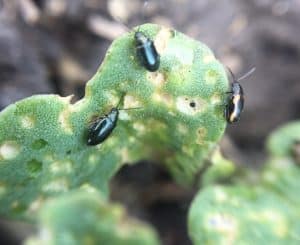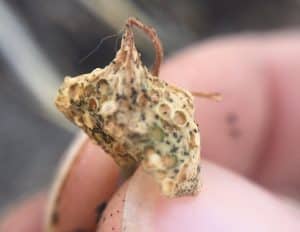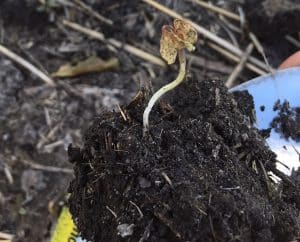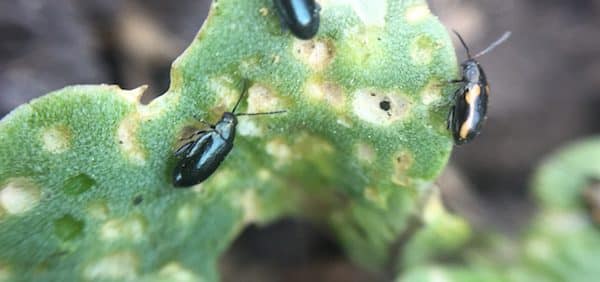Cool, dry conditions followed by hot and still dry conditions slowed canola plant growth in many regions. This slow growth could mean that seed treatment protection may not last until plants out-grow the flea beetle threat. See more on how to assess



Targeting headlands. With a complete close scout of sentinel fields, CCC agronomy specialists have observed higher flea beetle pressure at headlands, and especially at headlands close to trees. This makes sense as flea beetles will often overwinter at these treed sites. If flea beetles seem to be concentrated at headlands, a headland area spray can be an effective alternative to spraying the whole field. Scout the whole field a few days later to make sure the rest of the field is still below thresholds for damage.
Stem feeding. Wind often drives flea beetles to take shelter under leaves and on stems where they’ll continue feeding. Research on the effect of stem feeding is limited. We can assume however that stem feeding will be more damaging in young seedlings where one or two bites to the stem can impede the flow of nutrients and water up the plant. If conditions become hot and dry, this impeded flow can be particularly devastating.
When is the flea beetle threat over? Generally, when canola plants reach the 4-leaf stage, they have enough leaf area to overcome flea beetle feeding without any effect on yield. Once the crop starts to show its first and second true leaves, it should be OK as long as crop growing conditions are favourable. However, conditions that slow crop growth may not necessarily slow flea beetle feeding significantly (ex. dry). If the flea beetles are stalling plant development, an insecticide may be considered. Read more.
Weather conditions for sprays: Synthetic pyrethroids (Decis, Matador/Silencer, for examples) benefit from late-day spraying because they should be applied when temperatures are below 25°C.
Adding insecticide to herbicide because it’s cheap insurance. Some promotion bundling can make insecticides very low cost. Adding them to the herbicide tank mix may not add many dollars per acre to the crop protection bill. So this is cheap insurance, right? Perhaps. But if flea beetles are not at or near thresholds, the only result is an unnecessary and potentially high kill of beneficial insects.
How do seed treatments work? Insecticide seed treatments are systemic and require some feeding for the insect to take up the active ingredient. As systemic products, the active ingredient will be present in leaves and stems. Translocation to first and second leaves will depend on growing conditions and how fast the plant is growing. A slow-growing plant may not have translocation of seed treatment to true leaves. Observation of flea beetle behaviour may provide an indication: As long as there is active ingredient in the tissue, flea beetles will stop feeding almost immediately after they have some in their gut.
